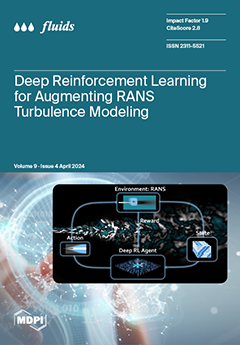In this work, the effects of jet impact angle and water flow on the heat-transfer coefficient in boron steel probes were analyzed. Angles of 90°, 75° and 60° were used with stirring flows of 33 l·min
−1, 25 l·min
−1, 13
[...] Read more.
In this work, the effects of jet impact angle and water flow on the heat-transfer coefficient in boron steel probes were analyzed. Angles of 90°, 75° and 60° were used with stirring flows of 33 l·min
−1, 25 l·min
−1, 13 l·min
−1 and 6 l·min
−1. The aim consisted of determining the heat-extraction rates by analyzing the correlation programmed in the Ansys Fluent 2020R2 software when different cooling conditions are used, avoiding many experiments, and establishing quenching conditions free of surface defects on the workpiece. This process is currently used in heavy machinery, requiring high hardness and wear resistance. The fluid-dynamic field was validated using a scale physical model using the particle image velocimetry technique, PIV. In contrast, the thermal field was validated with transient state experiments solving the inverse heat conduction problem, IHCP. The results show that for high flows (33 l·min
−1), the jets with an angle of 90° impact the entire surface of the piece, but their cooling rate is slower compared to the other angles, being 243.61 K·s
−1, and 271.70 K·s
−1, 329.56 K·s
−1 for 75° and 60°, respectively. However, for low flows (6 l·min
−1), the impact velocities are very similar for the three cases, promoting more homogeneous cooling rates of 58.47 K·s
−1, 73.58 K·s
−1 and 63.98 K s
−1 for angles of 90°, 75° and 60°, respectively. Likewise, through the use of CCT diagrams, it was determined that regardless of the cooling rate, the final structure will always be a mixture of martensite–bainite due to the effect of boron as determined experimentally, which implies a more significant proportion of martensite at higher cooling rates.
Full article





